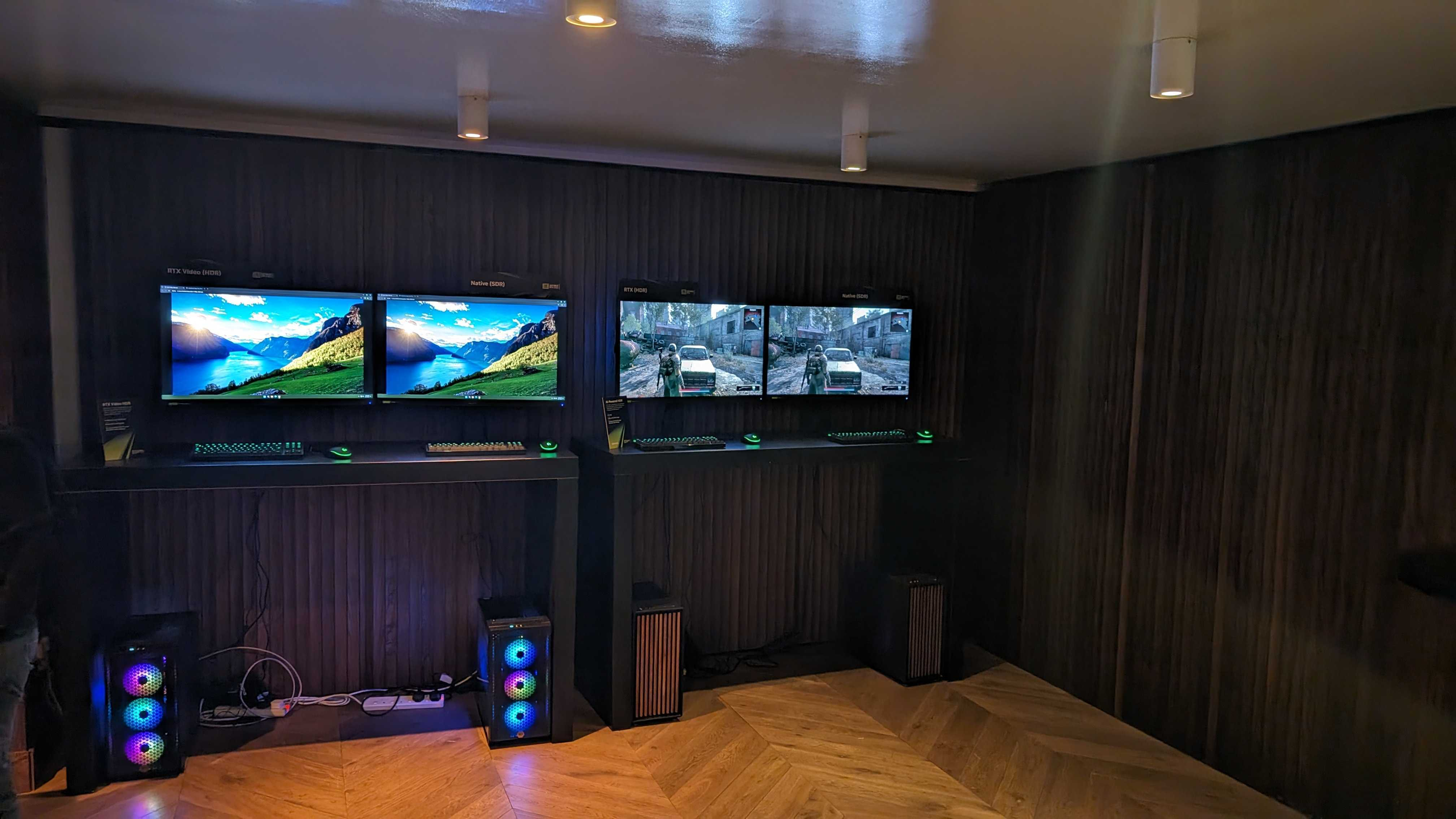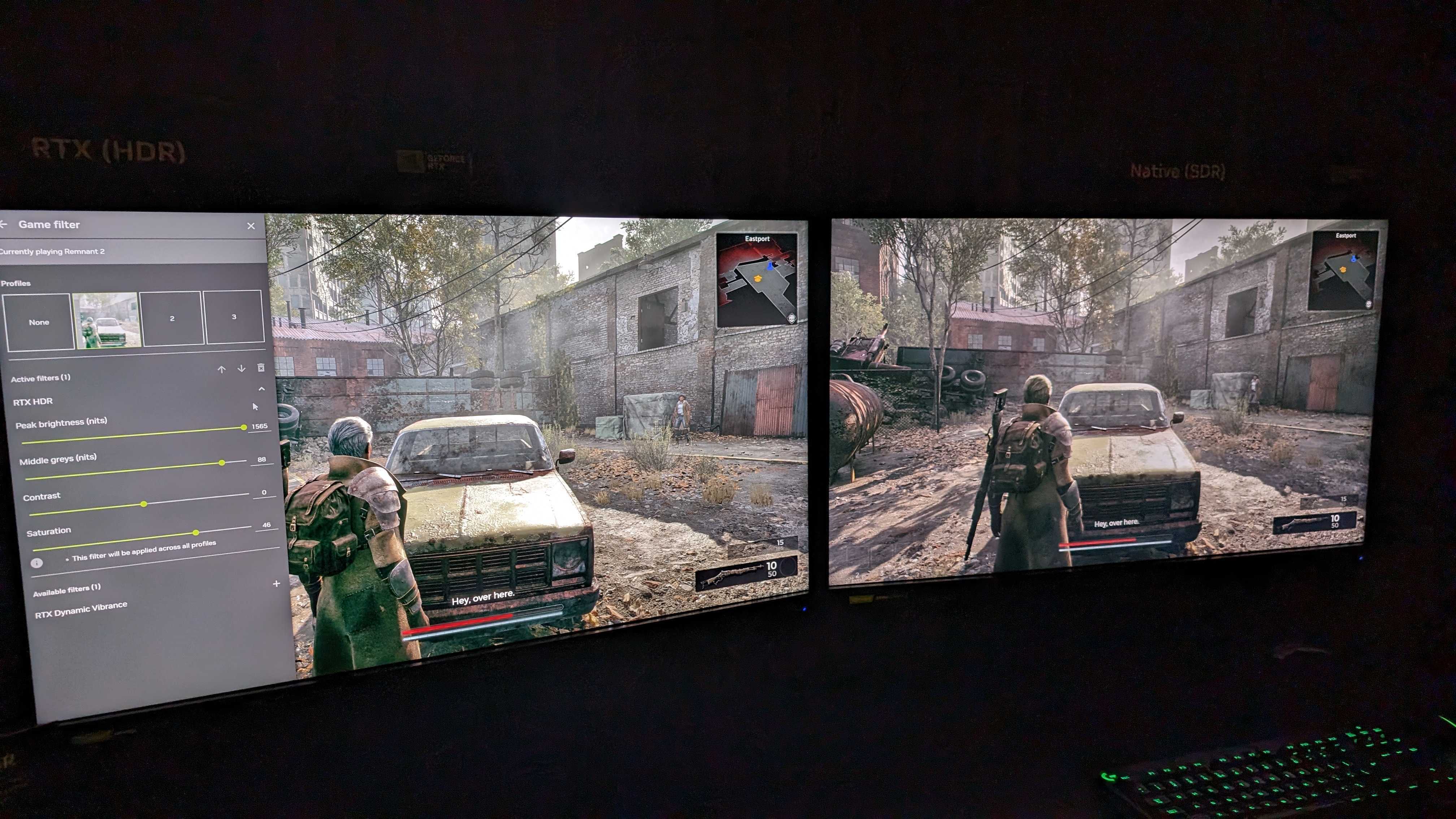I never cared about HDR content before, but Nvidia’s incredible AI-powered SDR-to-HDR demo has changed my mind
What if HDR was just a filter you could turn on?

I've never understood the obsession with HDR. High dynamic range (or more specifically, its initialism) has become an industry buzzword in recent years – from photography to computing, HDR is the hot topic.
"Does this display support HDR content?" is now a question I have to ask myself when I review a laptop or monitor. There's even a certain degree of mystique surrounding the technology; most people wouldn't be able to tell you the difference between HDR10 and HDR10+, beyond ‘10+ is better’. Until yesterday, I was one of those people.
Well, Nvidia, you did it. You've actually changed my mind about HDR – not because you convinced me that it's a necessary feature, but because you've successfully demystified it.
I attended a showcase of Nvidia’s latest AI-powered tech in London, and the software on show was a mixed bag, ranging from the mundane to the impressive. While it wasn't the focal point of the event – that honor went to the impressive Nvidia ACE gameplay demo – one thing that caught my attention was a new program for AI-powered HDR upscaling.

For the uninitiated, HDR is basically a categorization that denotes a wider range of color outputs for an image or video, compared to SDR (standard dynamic range). In practice, that means more detailed contrast and more vibrant and true-to-life color replication. If you want to enjoy the improved colors of HDR, you'll need two things: a display that supports at least some level of HDR, and content that has been produced in HDR. On the bright side, many of the best monitors these days do indeed feature HDR support.
Right now, that second requirement is the catch – whatever you want to watch or play has to be captured or rendered in HDR to begin with. It's possible to convert SDR video content to HDR (say, to upscale an old SDR TV show), but that requires actual work, and it's not applicable to games right now either. And that's where Nvidia comes in, with a new AI-powered RTX feature that can effortlessly convert any SDR content to HDR in real time, as simple as turning on a filter.
RTX On
I've largely ignored HDR because it's simply too complicated for me, as someone who doesn't professionally edit photos or videos. It sounds nice, but it doesn't really matter – I'm not going to go out of my way to seek out HDR content just because I have an HDR-capable monitor. But flipping on a filter and instantly getting better, brighter colors in my games? That I will do.
Sign up for breaking news, reviews, opinion, top tech deals, and more.
The live demo I was shown by Nvidia featured both a short video loop and a game, Remnant II. The difference was subtle but noticeable; Nvidia had set up two identical displays showing SDR and HDR content side-by-side to demonstrate. Remnant II was visibly more vibrant with RTX HDR turned on – and the best part of all was that it had effectively zero impact on performance.

Because this HDR upscaling is powered by AI, the machine-learning Tensor Cores in the RTX graphics card powering the demo handle the upscaling workload in the background, while the GPU’s primary graphics cores render the actual game itself. The result is that switching on the HDR filter – a remarkably quick and easy process using the Nvidia RTX overlay – doesn't reduce your frame rates or render quality by any meaningful amount. It's vanishingly rare for any feature that improves visual fidelity to not impact frame rates in some way, so I was suitably impressed.
Beyond that, this is also a way to make HDR content accessible to everyone. As long as you have an HDR-compliant screen (and HDR support is only becoming more common among the best gaming monitors), Nvidia assured me that literally anything can be upscaled from SDR with this simple tool. Old movies? Easy. Any random indie game? Done. You can even adjust specific elements of the RTX HDR filter with simple sliders, in case you want to up the contrast or peak brightness, for example.
It's a remarkably effective yet straightforward tool, and while as a PC gamer I'm excited to think about the gaming applications, I imagine this technology will have a major impact across other industries too. While some of the stuff Nvidia had to show off left me unconvinced, this is one area where Team Green has knocked it out of the park.
You might also like...
- Nvidia RTX 5090 and 5080 GPUs could be here in less than half a year – but scalpers might ruin this early launch
- Faulty RTX 4090 connectors are still burning out – and one ‘smart’ solution has created even more problems
- Horizon Forbidden West at 8K shows how powerful Nvidia DLSS is compared to AMD and Intel’s tech

Christian is TechRadar’s UK-based Computing Editor. He came to us from Maximum PC magazine, where he fell in love with computer hardware and building PCs. He was a regular fixture amongst our freelance review team before making the jump to TechRadar, and can usually be found drooling over the latest high-end graphics card or gaming laptop before looking at his bank account balance and crying.
Christian is a keen campaigner for LGBTQ+ rights and the owner of a charming rescue dog named Lucy, having adopted her after he beat cancer in 2021. She keeps him fit and healthy through a combination of face-licking and long walks, and only occasionally barks at him to demand treats when he’s trying to work from home.